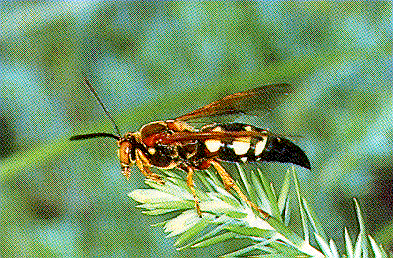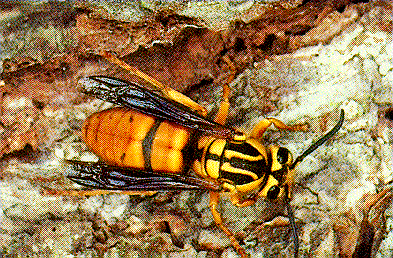Yard Wasps
ENTFACT-411: Yard Wasps | Download PDF
by Stephanie Bailey, Extension Specialist
University of Kentucky College of Agriculture
Several wasp species can be found around the yard. Although wasps feed on insects such as house flies and garden pests, some can also be dangerous to people. Most wasps typically ignore people. For example, social insects that live in colonies will readily sting when they perceive their nest or territory is threatened while solitary insects only sting in self-defense when mishandled. In addition, only female wasps can sting. In any case, it is best to regard any wasp with care before attempting to control it, since stings can be very painful. The best and easiest way to tell wasps apart is to look at the relative size of the wasp, and the pattern on the abdomen.
Small wasps include yellow jackets and white grub parasites. Yellow jackets are social insects. Fertilized queens overwinter,then start a colony in the spring and provision the first brood of young. Once the first brood has matured, they will take over the provisioning duties, care for the queen and the following broods throughout the summer. In late summer, reproductive males and females will be produced, which consequently mate and then the females overwinter (colonies always die out at the end of the year). In order to eliminate yellow jacket wasps that are indirect competition with humans, the entire colony or nest must be eliminated. Football-shaped nests may be either in the ground or above ground, and will be paperlike.
White grub parasites, usually of the genus Scolia, are solitary wasps. They fly low over lawns in mid- to late summer. They will insert their eggs inside white grubs, which are pests of lawns. The wasp larvae will feed on the grubs as they develop. These wasps are in far less competition with humans. However, they will sting if disturbed.
Large wasps (up to 2") include European hornets, baldfaced hornets and cicada killers. Cicada killers are solitary wasps, with the female provisioning larvae with cicadas in burrows in the soil during mid- to late summer. The larvae overwinter in their burrows. These wasps generally want nothing to do with humans and will rarely sting, even when bothered. European and baldfaced hornets, on the other hand, are colonial insects like yellow jackets. There is a reproductive queen, and many workers who tend the queen and the developing larvae. Nests are football-shaped and may be found in trees, shrubbery, or under eaves. These wasps are present well into the fall, but do not survive the winter. In order to control hornets, the nest of large, angry wasps must be eliminated. Proceed with extreme caution.
 Cicada Killer Wasp
Cicada Killer Wasp
 Yellow Jacket
Yellow Jacket
Finally, a medium-sized wasp named the velvet ant may also be present in lawns or pastures. These solitary wasps, as the name implies, are densely covered with hair. Males have wings, but females are wingless, and are sometimes confused with ants. Ants, however, have elbowed antennae, and a "hump" in the constriction between the thorax and abdomen. Velvet ants are either shades of brown or red and black, and females will sting if encountered.
Control
Many aerosol or pressurized sprays are available and provide quick knockdown. The best time to eliminate wasp nests is at night, when most workers are in the hive and resting. It is a good idea to prop a flashlight up, pointing at the entrance of the nest, but spray from a different spot. Wasps will go to the source of light rather than the source of spray. Also, heavy clothing and a bee veil, as well as safety glasses should be worn to prevent stings. After the hive has been thoroughly sprayed, remove the nest so pupae do not reestablish the work force.
Solitary, burrowing wasps like the cicada killer look for sparse, sandy soil to provision their offspring. Adequate fertilizer and watering will provide thick turf and could dissuade the cicada killers from burrowing. With severe infestations, or if young children are a concern, chemical control may be desired to remove any chance of stinging. Carbaryl (Sevin) applied to burrowed areas, following label directions for turf pests, can reduce infestations.
Additional Information
- ENTFACT 600 - The European Hornet in Kentucky
- ENTFACT 004 - Cicada Killer Wasp
- ENTFACT 606 - Controlling Nuisance Bees
- ENTFACT 620 - Controlling wasps, hornets, and yellow jackets
Revised: 7/19
CAUTION! Pesticide recommendations in this publication are registered for use in Kentucky, USA ONLY! The use of some products may not be legal in your state or country. Please check with your local county agent or regulatory official before using any pesticide mentioned in this publication.
Of course, ALWAYS READ AND FOLLOW LABEL DIRECTIONS FOR SAFE USE OF ANY PESTICIDE!
Images: University of Kentucky Entomology.
